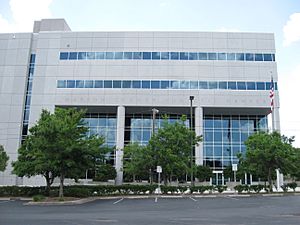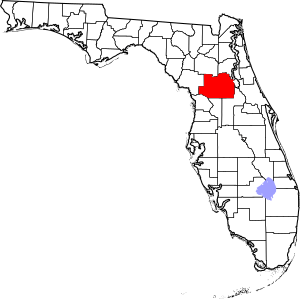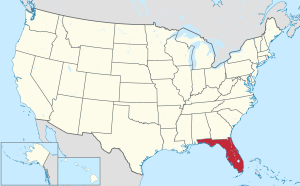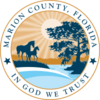Marion County, Florida facts for kids
Quick facts for kids
Marion County
|
||
|---|---|---|
|
County
|
||

Marion County Courthouse in Ocala
|
||
|
||

Location within the U.S. state of Florida
|
||
 Florida's location within the U.S. |
||
| Country | ||
| State | ||
| Founded | March 14, 1844 | |
| Named for | Francis Marion | |
| Seat | Ocala | |
| Largest city | Ocala | |
| Area | ||
| • Total | 1,663 sq mi (4,310 km2) | |
| • Land | 1,585 sq mi (4,110 km2) | |
| • Water | 78 sq mi (200 km2) 4.7%% | |
| Population
(2020)
|
||
| • Total | 375,908 | |
| • Estimate
(2023)
|
409,959 |
|
| • Density | 237/sq mi (92/km2) | |
| Time zone | UTC−5 (Eastern) | |
| • Summer (DST) | UTC−4 (EDT) | |
| Congressional districts | 3rd, 6th | |
Marion County is a county located in the North Central part of Florida. In 2020, about 375,908 people lived here. The main city and county seat is Ocala. Marion County is also part of the Ocala metropolitan area. A section of the Ocala National Forest is found within the county.
Contents
History
Marion County was created on March 14, 1844. It was formed from parts of other counties like Alachua, Mosquito (now Orange), and Hillsborough. Over time, some of Marion County's land was used to create new counties, such as Lake, Sumter, Putnam, and Levy.
The county is named after General Francis Marion from South Carolina. He was a famous "guerrilla fighter" during the American Revolutionary War. This means he led small groups of fighters who used surprise attacks against the enemy. Many early settlers in Marion County came from South Carolina, which is why they likely chose his name. The county's motto is "Kingdom of the Sun." Marion County is also famous for its farms that raise champion race horses, including famous ones like Affirmed and Needles.
Geography
Marion County covers about 1,663 square miles. Most of this area, about 1,585 square miles, is land, and 78 square miles is water. The county has rolling hills and is covered with trees like live oaks, pine, and palm trees.
Marion County is in the middle of Florida. It's considered the southernmost county in North Central Florida and the northernmost county in Central Florida. It's about a two-hour drive from many of Florida's big cities. For example, Orlando is about 75 minutes away, and Tampa is also about 75 minutes away. Jacksonville is roughly a two-hour drive northeast.
The county has three large lakes. Orange Lake is in the north, near Alachua County. Lake Kerr is in the northeast, close to Salt Springs. Lake Weir is the biggest lake and is in the southern part of the county, near Lake County. A small part of Lake George is also in Marion County.
Marion County is inland, meaning it's not directly on the coast. This helps protect it from the worst effects of hurricanes compared to coastal areas. However, strong winds and heavy rain from hurricanes can still affect the county. Tornadoes are also a possible threat in this region. Getting to the Gulf of Mexico (west coast) takes less than an hour, while reaching the Atlantic Ocean (east coast) takes about an hour and a half.
Adjacent counties
- Putnam County, Florida – northeast
- Volusia County, Florida – east
- Lake County, Florida – southeast
- Sumter County, Florida – south
- Citrus County, Florida – southwest
- Levy County, Florida – west
- Alachua County, Florida – northwest
National protected area
- Ocala National Forest (part)
Population Information
| Historical population | |||
|---|---|---|---|
| Census | Pop. | %± | |
| 1850 | 3,338 | — | |
| 1860 | 8,609 | 157.9% | |
| 1870 | 10,804 | 25.5% | |
| 1880 | 13,046 | 20.8% | |
| 1890 | 20,796 | 59.4% | |
| 1900 | 24,403 | 17.3% | |
| 1910 | 26,941 | 10.4% | |
| 1920 | 23,968 | −11.0% | |
| 1930 | 29,578 | 23.4% | |
| 1940 | 31,243 | 5.6% | |
| 1950 | 38,187 | 22.2% | |
| 1960 | 51,616 | 35.2% | |
| 1970 | 69,030 | 33.7% | |
| 1980 | 122,488 | 77.4% | |
| 1990 | 194,833 | 59.1% | |
| 2000 | 258,916 | 32.9% | |
| 2010 | 331,298 | 28.0% | |
| 2020 | 375,908 | 13.5% | |
| 2023 (est.) | 409,959 | 23.7% | |
| U.S. Decennial Census 1790-1960 1900-1990 1990-2000 2010-2019 |
|||
Marion County has grown a lot over the years. In 2020, there were 375,908 people living in the county. This included about 145,863 households and 94,676 families.
The population is made up of people from many different backgrounds. In 2020, about 67.5% of people were White (not Hispanic), and about 11.4% were Black or African American (not Hispanic). About 14.9% of the population was Hispanic or Latino.
In 2000, about 24.7% of households had children under 18. The average household had 2.36 people. The median age in the county was 44 years old. This means half the people were younger than 44, and half were older.
Law Enforcement
Law enforcement in Marion County is handled by several agencies. These include the Marion County Sheriff's Office and police departments in cities like Belleview, Dunnellon, and Ocala.
Education
Public education in Marion County is managed by the Marion County School District.
Public school system
The public school system includes:
- 28 elementary schools
- 8 middle schools
- 1 school for grades 4–8
- 1 center for grades K–8
- 10 high schools
- 3 charter schools
- 14 special needs schools
Elementary schools
- Anthony Elementary School
- Belleview Elementary School
- Belleview-Santos Elementary School
- College Park Elementary School
- Dr. N.H. Jones Elementary (magnet)
- Dunnellon Elementary School
- East Marion Elementary School
- Eighth Street Elementary School
- Emerald Shores Elementary School
- Fessenden Elementary School
- Fort McCoy School (K–8)
- Greenway Elementary School
- Hammett Bowen Jr. Elementary School
- Harbour View Elementary School
- Legacy Elementary School
- Madison Street Academy of Visual and Performing Arts (magnet)
- Maplewood Elementary School
- Oakcrest Elementary School
- Ocala Springs Elementary School
- Reddick-Collier Elementary School
- Romeo Elementary School
- Saddlewood Elementary School
- Shady Hill Elementary School
- South Ocala Elementary School
- Sparr Elementary School
- Stanton-Weirsdale Elementary School
- Sunrise Elementary School
- Ward-Highlands Elementary School
- Wyomina Park Elementary School
Middle schools
- Belleview Middle School
- Dunnellon Middle School
- Fort King Middle School
- Fort McCoy School (K–8)
- Horizon Academy at Marion Oaks
- Howard Middle School
- Lake Weir Middle School
- Liberty Middle School
- North Marion Middle School
- Osceola Middle School
div col end}}
High schools
- Belleview High School
- Dunnellon High School
- Forest High School
- Lake Weir High School
- Marion Technical Institute
- North Marion High School
- Vanguard High School
- West Port High School
Private schools
- Ambleside School Of Ocala, grades K–8
- Belleview Christian Academy, grades PK–9
- Blessed Trinity School, grades K–9
- Children's Palace East & Academy, grades K–2
- The Cornerstone School, grades PK–8
- Crossroads Academy, grades 3–12
- Grace Building Blocks School, grades K–2
- Grace Christian School, grades PK–8
- Meadowbrook Academy, grades K–12
- Montessori Preparatory School, grades K–5
- New Generation School, grades K–12
- Ocala Christian Academy, grades PK–12
- Ocean's High School, grades PK–12
- Promiseland Academy, grades K–7
- First Assembly Christian School, grades PK–12
- The Reading Clinic, grades 2–6
- Redeemer Christian School, grades K–12
- The Rock Academy, grades PK–9
- The School of the Kingdom, grades 1–12
- Shiloh SDA Church School
- St John Lutheran School, grades PK–12
- Trinity Catholic, grades 9–12
Libraries
The Marion County Public Library System has eight branch libraries for everyone to use.
Transportation
Airports
Marion County has two airports:
- Dunnellon/Marion County Airport
- Ocala International Airport
Major Roads
 I-75 is a major highway that runs north and south through the middle of the county.
I-75 is a major highway that runs north and south through the middle of the county. US 41 goes north and south through Dunnellon.
US 41 goes north and south through Dunnellon. US 27 runs northwest and southeast through the county, including Ocala.
US 27 runs northwest and southeast through the county, including Ocala. US 301 is another main north-south road, passing through Belleview and Ocala.
US 301 is another main north-south road, passing through Belleview and Ocala. US 441 also runs northwest and southeast, connecting areas like Belleview, Ocala, and McIntosh.
US 441 also runs northwest and southeast, connecting areas like Belleview, Ocala, and McIntosh. SR 19 runs along the eastern edge of the county, through the Ocala National Forest.
SR 19 runs along the eastern edge of the county, through the Ocala National Forest. SR 40 is the main road going west to east, connecting Dunnellon, Ocala, and Silver Springs.
SR 40 is the main road going west to east, connecting Dunnellon, Ocala, and Silver Springs. SR 200 runs northeast and southwest from Citrus County into Ocala.
SR 200 runs northeast and southwest from Citrus County into Ocala.
Railroads
CSX operates a train line in the county. Amtrak used to offer passenger train service to Ocala, but it stopped in 2004. The Florida Northern Railroad also has freight lines in the county.
Public Transportation
Local bus service in Marion County is provided by SunTran.
Communities
Cities
Towns
Census-designated places
- Silver Springs Shores
- The Villages (partly in Sumter County)
Other communities
See also
In Spanish: Condado de Marion (Florida) para niños


